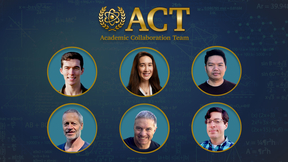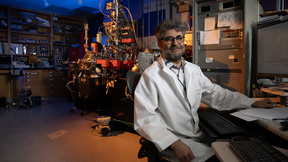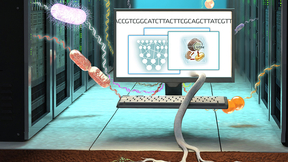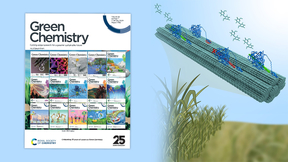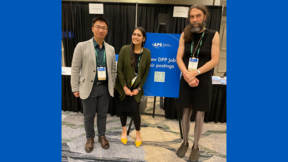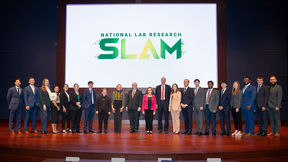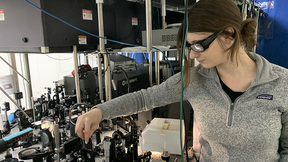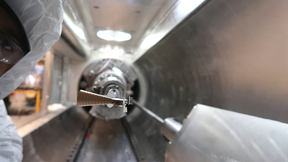Back
Physical and Life Sciences
Strategic Deterrence Academic Collaboration Team awards six scientists to support collaborative research
Six scientists at the Lawrence Livermore National Laboratory (LLNL) were recently granted awards through the Lab’s 2023 Academic Collaboration Team (ACT) annual call for proposals. Awards support university research partners for up to three years to perform research in collaboration with Lab scientists and offer an important way to build long-term connections with…
Microbial research unravels a global nitrogen mystery
Ammonia-oxidizing microorganisms (AOM) use ammonia for energy and account for the annual oxidation of approximately 2.3 trillion kilograms of nitrogen in soil, freshwater, the subsurface and man-made ecosystems. But one major question that has remained unanswered for decades is how different AOM species coexist in the same environment: do they compete for ammonia or…
Underneath it all: building a better understanding of carbon use by soil microbes
Microbes are major drivers of carbon and nutrient fluxes in Earth’s terrestrial ecosystems; however, Earth system models used for climate change adaptation and mitigation strategies typically exclude explicit representation of soil microorganisms. A team of researchers from Lawrence Livermore National Laboratory (LLNL), Lawrence Berkeley National Laboratory (LBL) and…
Using agricultural residues for fuel and chemicals
A Lawrence Livermore National Laboratory (LLNL) scientist is part of a research team shedding new light on how to access the sugars locked up in plant materials in order to convert byproducts into new feedstocks for production of fuels, materials and chemicals. Converting grasses, weeds, wood and other plant residues into sustainable products normally produced using…
Lawrence Livermore’s popular 'Science on Saturday' lecture series returns to Las Positas College
Lawrence Livermore National Laboratory's (LLNL) popular lecture series, “Science on Saturday,” returns Feb. 3 and runs through Feb. 24. The series offers four different lectures with the theme, “Magic of Materials.” Each lecture is presented by leading LLNL researchers who are joined by high-school science teachers. Below is the schedule of lectures, which can also be…
Synthetic antibacterial minerals combat topical infections
The development of new antibiotics has stalled — new strategies are needed as the world enters the age of antibiotic resistance. To combat this challenge, Lawrence Livermore National Laboratory (LLNL) scientists have found that synthetic antibacterial minerals exhibit potent antibacterial activity against topical MRSA infections and increase the rate of wound closure…
The hidden symphony of soil: decoding viral dynamics and microbial mortality after the first rainfall
Soil is a highly complex microbial habitat that is home to tens of millions of microbial populations, where biotic and abiotic factors shape microbial community structure. Moments of acute pressure on a community, such as rapid environmental changes or fluxes in resource availability, drive successional trajectories that result in altered community structures. One such…
New study reveals surprising behavior of iron under extreme conditions
Iron is one of the world’s most abundant elements and a primary component of the Earth's core. Understanding the behavior of iron under extreme conditions, such as ultra-high pressures and temperatures, has implications for the science of geology and the Earth’s evolution. In a study conducted by a team led by Lawrence Livermore National Laboratory. researchers combined…
Two LLNL Physicists named American Physical Society Career Mentoring Fellows
PLS staff physicists Ben Zhu and Veronika Kruse were selected by the American Physical Society (APS) as Career Mentoring Fellows for 2023-2024. Ben belongs to PLS’s Fusion Sciences program and Veronika is in the High Energy Density Science section. Part of their duties involve attending selected APS conferences such as the Division of Plasma Physics (DPP) meeting,…
New analysis outlines national opportunities to remove CO2 at the gigaton scale
Lawrence Livermore National Laboratory (LLNL) researchers, along with scientists from more than a dozen institutions, have completed a first-of-its-kind high-resolution assessment of carbon dioxide (CO2) removal (CDR) in the United States. The report, “Roads to Removal: Options for Carbon Dioxide Removal in the United States,” charts a path for the United States to achieve…
Resolving astronomical mysteries
A new satellite called XRISM (X-ray Imaging and Spectroscopy Mission, pronounced “crism”) was successfully launched from the Tanegashima Space Center in Japan on Sep. 7, 2023. XRISM is a collaboration between the Japan Aerospace Exploration Agency (JAXA) and National Aeronautics and Space Administration (NASA), with European Space Agency participation, to study extreme…
SHASTA Lays Foundations for Hydrogen Energy Storage
Abundant and non-polluting, hydrogen gas could help meet growing domestic energy demand while spurring a low-carbon economy and reinforcing energy reliability, diversification, and independence.
Geophysicist characterizes the earth while forming community at Livermore
Geophysicist Christina “Chris” Morency’s research has led her around the globe to demystify the world beneath our feet. Since arriving at Lawrence Livermore National Laboratory (LLNL) in 2011, she has held leadership roles on numerous research teams and has worked diligently to make Lawrence Livermore a welcoming place for all. Originally from France, Morency said she is …
Record-setting SC23 builds mile-high momentum for exascale computing, AI, and the future of HPC
The crowds returned to SC, and with them came a renewed excitement for the future of high performance computing (HPC). A record number of attendees — more than 14,000 — experts, researchers, vendors and enthusiasts in the field of HPC descended on the Mile High City for the 2023 International Conference for High Performance Computing, Networking, Storage and Analysis,…
Inaugural National Lab Research SLAM showcases early-career researchers
Gathered in the Congressional Auditorium on Wednesday, Nov. 15, 17 early-career researchers used three minutes and a single slide to present their pioneering research during the inaugural National Lab Research SLAM. Representing each of the 17 Department of Energy (DOE) national laboratories, finalists presented in four research categories: Energy Security, National…
LLNL-led SCREAM team clinches inaugural Gordon Bell Prize for climate modeling
A Lawrence Livermore National Laboratory (LLNL)-led effort that performed an unprecedented global climate model simulation on the world’s first exascale supercomputer has won the first-ever Association for Computing Machinery (ACM) Gordon Bell Prize for Climate Modelling, ACM officials announced Thursday. The Simple Cloud Resolving E3SM Atmosphere Model (SCREAM) team, led…
Just add salt: Researchers explore a new electricity-free cooling method
Rising global temperatures are creating an increased demand for cooling as the number of air-conditioning units used worldwide is expected to triple by 2050. However, with 13% of the global population without access to electricity, solutions that can provide cooling without electricity are needed. In a study published in Materials Horizon, a Lawrence Livermore National…
Watching aluminum’s reaction under extreme pressure
Understanding laser material interactions has applications that include inertial confinement fusion, material research and equation of state studies. Laser ablation, and specifically increasing the pressure that can be achieved from a laser system, is a longstanding topic of scientific research with implications ranging from damage in layered devices like solar cells and…
Probing the temperature of materials under extreme pressure
In new experiments at Lawrence Livermore National Laboratory’s National Ignition Facility, scientists measured the extended X-ray absorption fine structure (EXAFS) of copper to probe its temperature under extreme pressure. The research appears in the journal Nature Communications. Dynamic compression experiments at high-energy-density laser facilities have expanded the…
Migration of elements found in nuclear waste may get a boost from natural proteins
Past and present nuclear activities (energy, research and weapon tests) have increased the need to understand the behavior of radioactive materials in the environment. Nuclear wastes containing actinides (such as plutonium, americium, curium and neptunium) are particularly problematic as they remain radioactive and toxic for thousands of years. However, when compared to…


